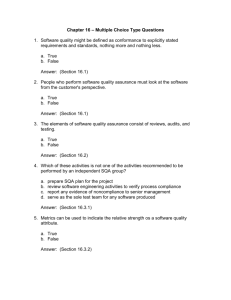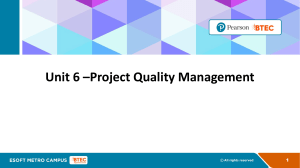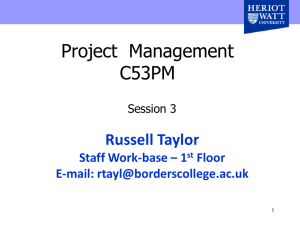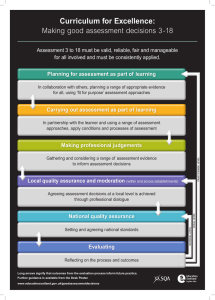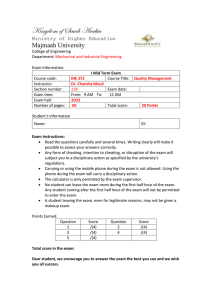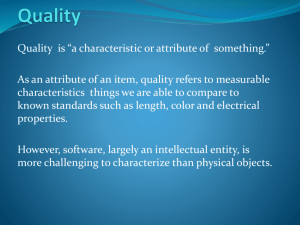quality management plan
advertisement
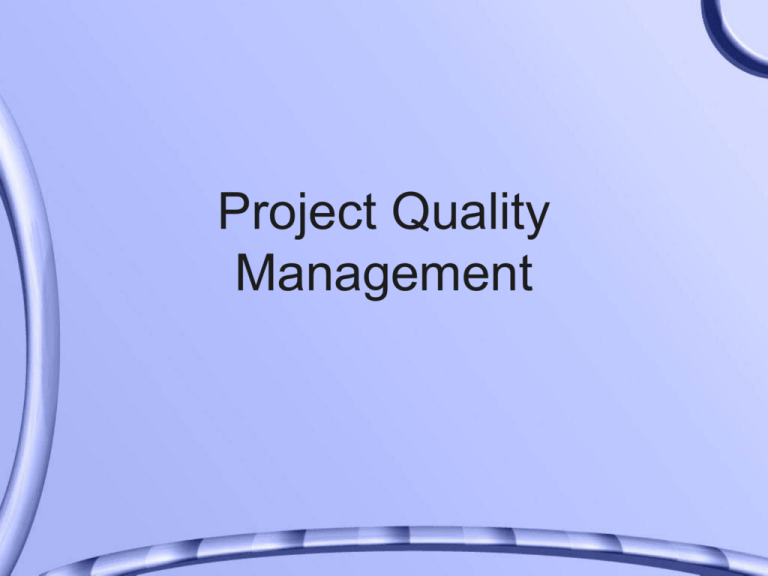
Project Quality Management What is Project Quality Management? • Quality is the degree to which a set of inherent characteristics fulfill requirements • Other experts define quality based on – conformance to requirements: meeting written specifications – fitness for use: ensuring a product can be used as it was intended • One of fundamental tenets of modern quality management is: quality is planned, designed and built in-not inspected in Project Quality Management Processes • Quality Planning: identifying which quality standards are relevant to the project and how to satisfy them • Perform Quality Assurance: applying the planned, systematic quality activities to ensure that the project employs all processes needed to meet requirements • Perform Quality Control: monitoring specific project results to determine whether they comply with relevant quality standards and identifying ways to eliminate causes of unsatisfactory performance Modern Quality Management • Recognize the importance of – Customer satisfaction – Prevention over inspection – Management responsibility – Continuous improvement Quality Planning • It is important to design in quality and communicate important factors that directly contribute to meeting the customer’s requirements • Design of experiments helps identify which variable have the most influence on the overall outcome of a process • The cost of quality refers to the total cost of all effort related to quality • The quality management plan describes how the project management team will implement the performing organization’s quality policy The Cost of Quality • The cost of quality is – the cost of conformance or delivering products that meet requirements and fitness for use – the cost of nonconformance or taking responsibility for failures or not meeting quality expectations Five Cost Categories Related to Quality • Prevention cost: the cost of planning and executing a project so it is error-free or within an acceptable error range • Appraisal cost: the cost of evaluating processes and their outputs to ensure quality • Internal failure cost: cost incurred to correct an identified defect before the customer receives the product • External failure cost: cost that relates to all errors not detected and corrected before delivery to the customer • Measurement and test equipment costs: capital cost of equipment used to perform prevention and appraisal activities Perform Quality Assurance • • • • Quality assurance includes all the activities related to satisfying the relevant quality standards for a project Another goal of quality assurance is continuous quality improvement QA support, regardless of the unit’s title, may be provided to the project team, the management of the performing organization, the customer or sponsor, as well as other stakeholders not actively in the work of the project Quality audits help identify lessons learned that can improve performance on current or future projects Perform Quality Control • Quality control measurements represent the result of QC activities that are feedback to QA to reevaluate and analyze the quality standards and processes of the performing organization • A goal of quality control is to determine the correctness of deliverables • The result of the execution QC processes are validated deliverables Testing • Many IT professionals think of testing as a stage that comes near the end of IT product development • Testing should be done during almost every phase of the IT product development life cycle Tasks in the Software Development Life Cycle Types of Tests • A unit test is done to test each individual component (often a program) to ensure it is as defect free as possible • Integration testing occurs between unit and system testing to test functionally grouped components • System testing tests the entire system as one entity • User acceptance testing is an independent test performed by the end user prior to accepting the delivered system Gantt Chart for Building Testing into a Systems Development Project Plan Project Quality Management Processes
